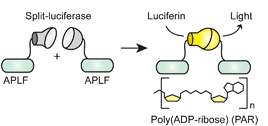Chemistry, Department of: Faculty Series
ORCID IDs
Document Type
Article
Date of this Version
2010
Abstract
The ability to conditionally turn on a signal or induce a function in the presence of a user-defined RNA target has potential applications in medicine and synthetic biology. Although sequence-specific pumilio repeat proteins can target a limited set of ss- RNA sequences, there are no general methods for targeting ssRNA with designed proteins. As a first step toward RNA recognition, we utilized the RNA binding domain of argonaute, implicated in RNA interference, for specifically targeting generic 2-nucleotide, 3′ overhangs of any dsRNA. We tested the reassembly of a split-luciferase enzyme guided by argonaute-mediated recognition of newly generated nucleotide overhangs when ssRNA is targeted by a designed complementary guide sequence. This approach was successful when argonaute was utilized in conjunction with a pumilio repeat and expanded the scope of potential ssRNA targets. However, targeting any desired ssRNA remained elusive as two argonaute domains provided minimal reassembled split-luciferase. We next designed and tested a second hierarchical assembly, wherein ssDNA guides are appended to DNA hairpins that serve as a scaffold for high affinity zinc fingers attached to split-luciferase. In the presence of a ssRNA target containing adjacent sequences complementary to the guides, the hairpins are brought into proximity, allowing for zinc finger binding and concomitant reassembly of the fragmented luciferase. The scope of this new approach was validated by specifically targeting RNA encoding VEGF, hDM2, and HER2. These approaches provide potentially general design paradigms for the conditional reassembly of fragmented proteins in the presence of any desired ssRNA target.
Includes Supplementary Materials.



Comments
Published in Journal of the American Chemical Society 132:33 (2010), pp 11692–11701; doi: 10.1021/ja104395b Copyright © 2010 American Chemical Society. Used by permission.